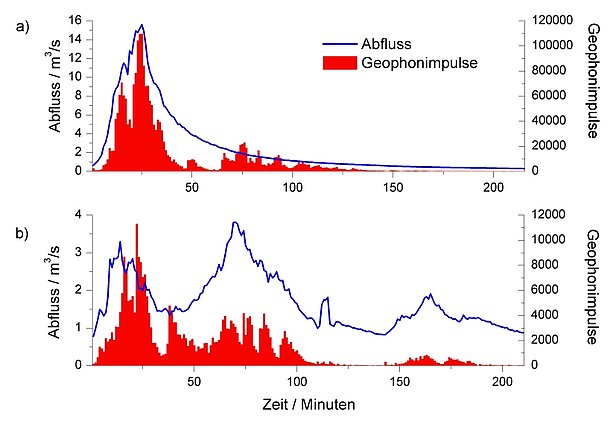High waters in mountain torrents often sweep away large quantities of sediment and/or trigger debris flows. Measuring bedload transport in natural torrents is important, as it enables us to better understand the processes involved and to develop methods for calculating the risks.
Contents ¶
When a certain water volume (discharge threshold) is surpassed, the flow of a mountain torrent can set in motion stones and sand from the stream bed. The more water flowing and the steeper the channel, the greater the bedload transport. The quantity of bedload that can be transported depends on the structure of the stream bed and how much rock and earth ends up in the torrent as a result of landslides and bank erosion.
Years' worth of bedload transport measurements indicate that after extreme flood events or the passage of a debris flow, larger bedload quantities can be mobilised and displaced than after longer «quiet» periods.
A major part of the research on bedload transport is conducted at WSL's hydrological test sites in Alptal (canton of Schwyz), especially in the Erlenbach and Vogelbach streams. Our hydrological research in Alptal began back in 1967; the bedload measuring stations at the Vogelbach and Erlenbach were installed in 1982 and 1994. Both here and at other streams, we continuously measure bedload transport using geophone sensors (formerly: hydrophone sensors).
Measuring the bedload transport ¶
A geophone is a device that measures vibrations. It is secured to the underside of a steel plate, which is built into the solid channel bed. When a bedload particle rolls over the plate, it triggers vibrations that are registered by the sensor. These signals are saved electronically and geophone impulses are counted in a simplified way to constitute a measure of bedload transport. To quantify the bedload transport, we have to calibrate this system with independent bedload measurements (e.g. in a retention basin).

In parallel, we have recently installed automatic basket samplers in the Erlenbach, for example, which collect bedload for a certain period of time. These allow us to more accurately determine how much bedload there is at what time and how large the grain is, and to calibrate this with the geophone measurements.
In 2019, we carried out further bed load measurements for calibration using catch nets, among others in Albula (GR), where we also installed a bed load measuring system in 2015. The aim is to link the signals of geophones with certain amounts of bedload.
Research objectives ¶
- Vollect long-term data series on sediment transport in a small catchment.
- Calibrate and further develop the acoustic bedload measurement method (geophones).
- Measure bedload transport and its variability in mountain torrents under different boundary conditions (geology, soil, vegetation, climate, bedload availability).
- Obtain a basic for characterising torrents and estimating the dimensions of protection structures and the hazard assessment for downstream areas.
- Determine the most important factors that control sediment yield in steep torrents and mountain streams and develop predictive calculation methods.
Scientific methods ¶
- Measuring bedload transport rates with geophone and acceleration sensors.
-
Targeted collection of bedload samples with automatic bedload basket samplers during flood events
- Determining annual sediment yields by surveying retention basins.
- Periodic monitoring of channel geometry, streambed morphology and grain size distribution in selected channel sections.
- Derivation of predictive methods for the calculation of transported bedload quantities.


